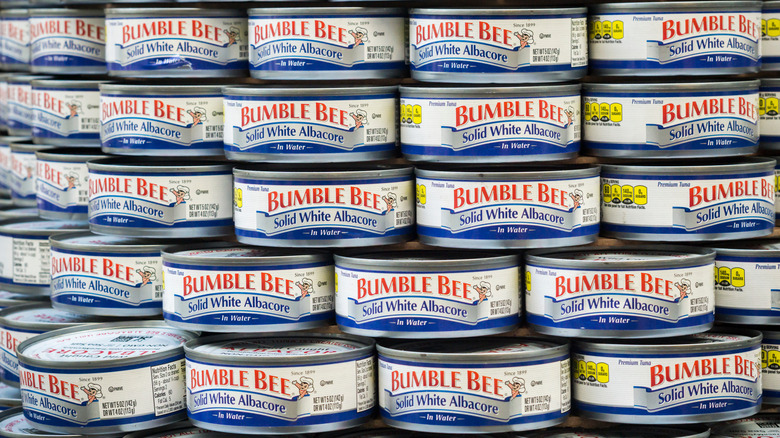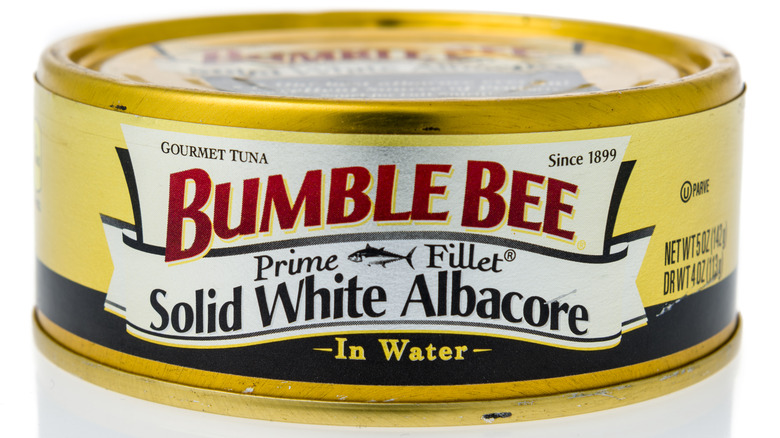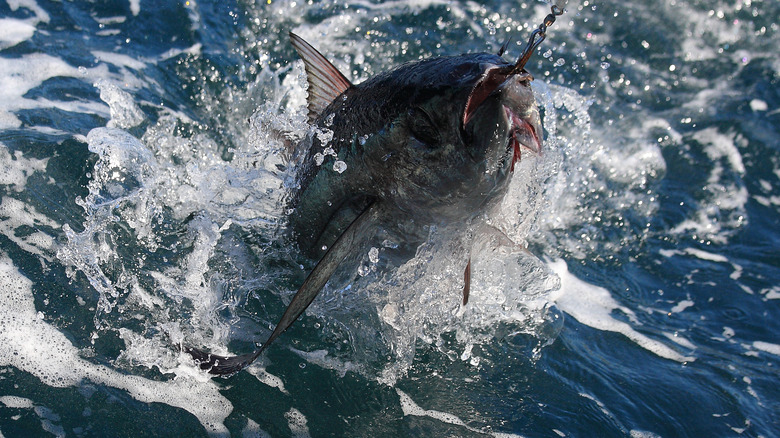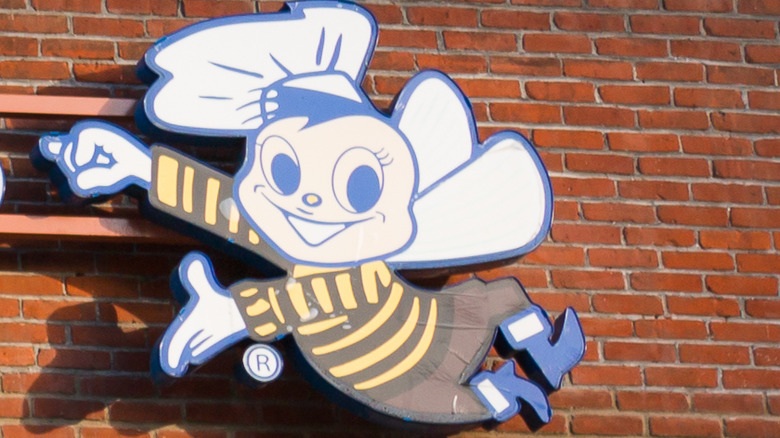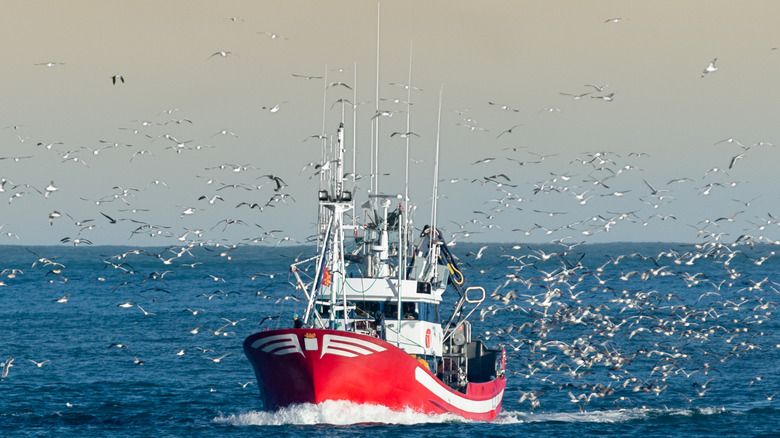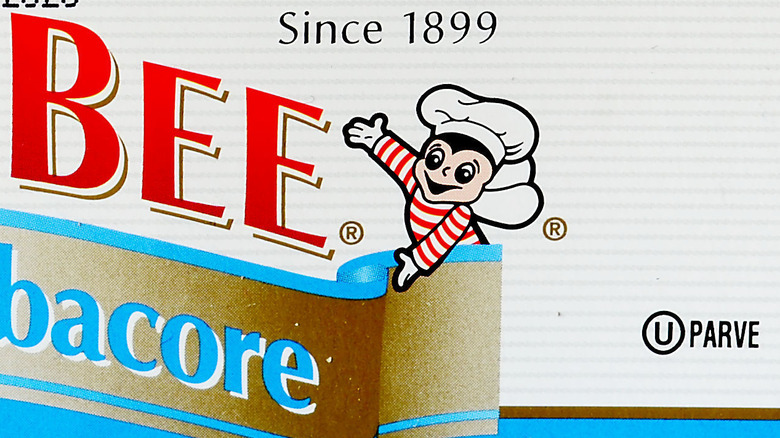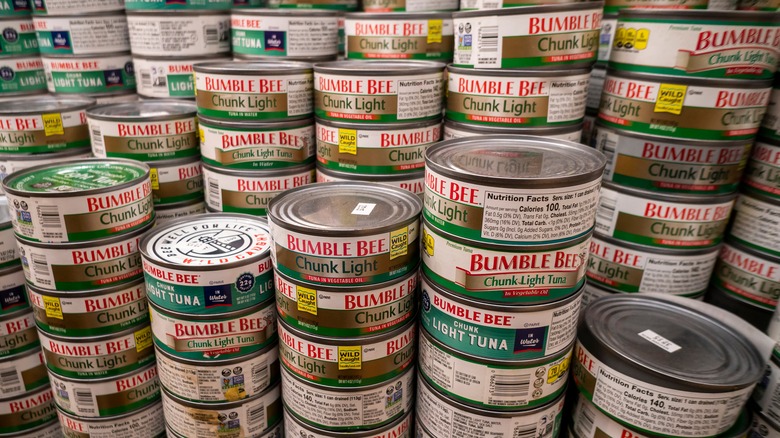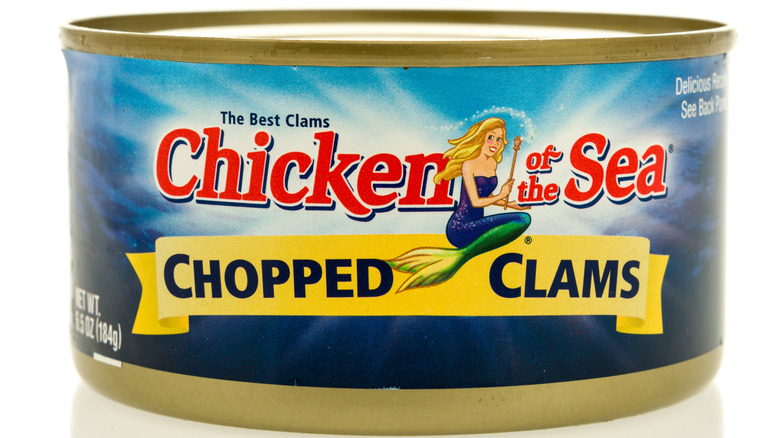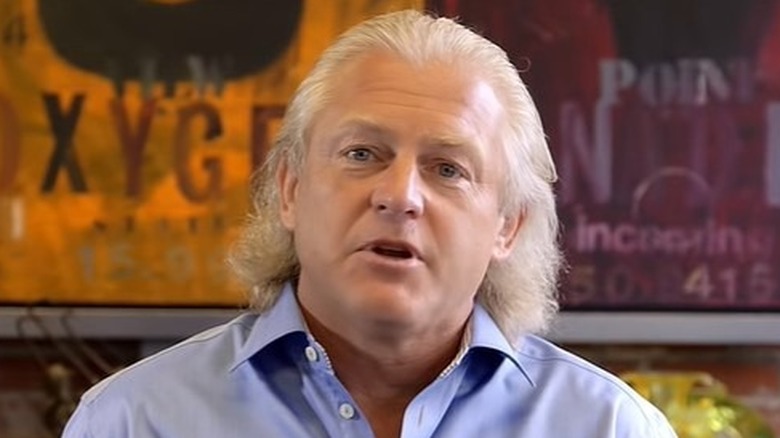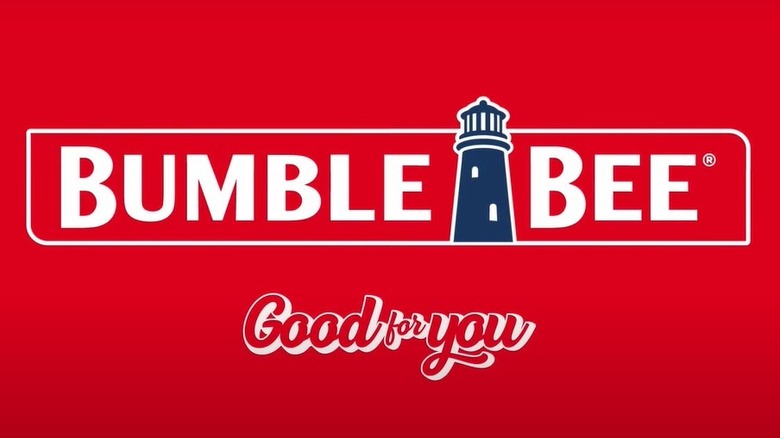The Untold Truth Of Bumble Bee Tuna
It's genuinely difficult to top the economic and nutritional bang-for-your-buck offered by canned tuna. Both cheap and healthy in equal measure, you can just about guarantee this superbly diverse, preserved protein will be found in any kitchen pantry in the U.S.
Countless options exist for both brands and varieties of canned tuna, but Bumble Bee Tuna's dependable flavor and thier lid that, from our experience, doesn't bend and spray juice everywhere when you drain it, as some brands do — have contributed to Bumble Bee remaining popular for several decades. It may have consistently ranked behind the two other canned tuna titans (Starkist and Chicken of the Sea) in sales in 2020 according to Statista, but it is still one of the most consumed tuna brands among Americans.
There's a long and colorful story behind Bumble Bee Tuna and its (now-former) bumblebee mascot, Horatio — from its early beginnings as a collective of salmon fisheries in the Pacific Northwest, to its more recent legal and financial woes. If you're curious about the history of this thoroughly American product, grab your life vests and Dramamine pills, and set sail with us to discover the untold truth of Bumble Bee Tuna.
The company was founded in 1899 as the Columbia River Packers Association (CRPA)
Have you ever considered the origins of a seemingly always-available product, like Bumble Bee Tuna? Well, if you've ever wondered about this tuna industry giant's history, you may be surprised to learn that when a group of commercial fishing companies joined forces to form the original company, it wasn't under the name Bumble Bee Tuna — it was known as the Columbia River Packers Association (CRPA), per The Daily News.
Founded in Astoria, Oregon in 1899 — where its headquarters remained for the next 81 years — the CRPA was a collective formed by A.B. Hammond, who hoped this conglomeration of seven commercial fishing companies would boost the group's business prowess. And while many would likely assume tuna was always the company's bread-and-butter, the original focus was canned salmon. Per Bumble Bee's company website, around 1910 they realized there was an "abundance of albacore" in the Pacific areas they fished and by 1930 canned tuna became the company's top product.
What, exactly, prompted the company's name to eventually evolve into its current, more well-known moniker, it's unclear. But where it comes from is fairly simple: Bumble Bee was the name of one of the seven fishing companies that founded the CRPA.
The Bumble Bee brand itself was started in 1910
While the Bumble Bee fishing firm was one of the seven purchased by A.B. Hammond to form the CRPA in 1899 (via The Daily News), it clearly didn't become its own canned tuna (or salmon) brand right away. But as the CRPA grew in the following decades — and as the number of albacore tuna caught off the shores of the Pacific Northwest induced the need to diversify its products through different brands — it eventually created a number of new product names, which included the Bumble Bee label in 1910.
The Bumble Bee brand, and the variety of albacore tuna being sold, were quickly recognized as a superior product by consumers from all walks of life (via Orthodox Union). Not that this led to an immediate shift in the company's priorities, or meant that Bumble Bee Tuna was an instant smash across the nation. Salmon still reigned supreme during the 1910s, after all.
In time, though, as you probably guessed, both tuna and the Bumble Bee brand came to dominate the company's attention — and bottom line. And, in 1960, the entire company was rebranded as Bumble Bee Seafoods.
The rise of albacore fishing in the 1930s shifted its focus to tuna
Clearly, when Bumble Bee's original company first started, its main financial interest was the sale of salmon rather than tuna. Salmon's overall abundance and cheap cost, in comparison to other proteins available during the early years of the 20th century, made it hugely popular through the 1910s — before overfishing began the slow decline of its nationwide prevalence (via Northwest Power and Conservation Council).
But the lack of restraint by salmon fishermen wasn't the sole reason for tuna's eventual rise, as the number of albacore tuna found in the Pacific Northwest remained plentiful after the Bumble Bee label was introduced in 1910. Eventually, it became clear that tuna was destined to usurp salmon on the company leaderboard, and the shift towards tuna supremacy appeared complete by the end of the 1930s. This was reiterated in the book, "Flight of the Bumble Bee: The Columbia River Packers Association & a Century in the Pursuit of Fish," by Irene Martin (via The Daily News), who wrote how "three years between 1936 and 1939 changed the entire fabric" of the company.
Of course, it's entirely possible tuna's eventual coronation over salmon would have happened with or without the boom in albacore caught by fishermen. After all, as Martin mentioned in her book, frozen albacore tuna maintains quality when defrosted (unlike salmon), meaning tuna may have always been destined to be the tortoise to salmon's hare.
Famous mascot, Horatio the Bumble Bee, was introduced in 1950
The consistency offered in each and every can or pouch of Bumble Bee Tuna isn't the only reason it continues to resonate in the public's consciousness. Sure, being a delicious food item certainly helped it become one of the three biggest canned tuna brands in the U.S. as of 2020. But it's also easy to imagine a world where Bumble Bee remained little more than a popular-but-middling brand — if it had never introduced the world to its famous cartoon mascot, Horatio, in 1950.
Described by the company as a "long-loved icon of the brand," Horatio the bumblebee (get it?) was an adorable addition to the company's packaging and promotions. Always sporting a tall chef's hat — and sometimes clothes, as was the case with later anthropomorphized versions of the character — the cartoon bumblebee was a staple of the company's packaging for six decades.
Yet all good things must end, as they say. So, in 2020, Horatio was put out to pasture and "retired" by the company, as part of a brand makeover (via Intrafish).
The name Bumble Bee comes from a fishing boat
The name Bumble Bee being used for a seafood product may seem incomprehensible at first glance. Surely, you're thinking (if you're unaware of the company's history, that is), there must be a breed of fish named "bumblebee" that led to the insect-inspired label, akin to the catfish or alligator gar. But the mystery isn't all that mysterious when you dig into it, frankly, as the name comes from a fishing fleet boat local to Astoria, Oregon during the 1890s and 1900s, according to The Bumble Bee Company.
The Bumble Bee wasn't just a well-known and successful fishing fleet boat familiar to fishing companies at the time, though. It was actually from one of the seven fishing companies that formed the predecessor to Bumble Bee, CRPA, in 1899.
We're not sure why, exactly, the Bumble Bee label came to be the defining brand under the company's umbrella. But considering the clear reputation for quality it developed in the wake of its introduction (via Orthodox Union), it may be a simple case of the cream rising to the top.
It's had some unique moments in the cultural spotlight
Given Bumble Bee Tuna has been in business under various names and ownership since 1899, its pop-cultural breakout or two isn't exactly shocking. Part of this can be attributed to the legacy of its earworm jingle, "yum, yum, Bumble Bee Tuna," which has been featured in numerous commercials through the years — and a 1994 song by ska band, Mephiskapheles, that incorporated the tune.
But Bumble Bee's 15 minutes of cultural fame aren't limited to unusually-arranged covers that integrate a beloved jingle. For fans of Jim Carrey in the 1990s — which was most of the world, quite frankly — the brand was immortalized in a scene from "Ace Ventura: When Nature Calls." When the titular pet detective heads to an African village (for reasons) during the film, he misunderstands a local greeting, leading Carrey's character to wander around gleefully wishing, "Bumble Bee Tuna!" to all he encounters.
It hasn't always been sunshine and lollipops, though. For instance, an unfounded accusation by former president Donald Trump in 2020, that cans of Bumble Bee Tuna were being thrown at police by protestors (via Business Insider), wasn't backed by any evidence, or any shreds of proof. Yet the company still felt the need to conduct damage control in the comment's wake, prompting a simple response on Twitter regarding its canned products: "Eat em. Don't throw em."
It offers popular kosher products to consumers
As any number of judicial rulings have reiterated throughout U.S. history, the right to one's religious freedom is sacrosanct in this nation (at least, it is if you follow a Christian-centric religion, as 2022 rulings illustrated). One's ability to follow the religion of their choosing, and have the necessary items available for any and all religious endeavors as needed, has spurred numerous companies to develop niche products that meet those specifications for followers of various beliefs. This includes Bumble Bee, which notes on its website that the majority of its offerings are kosher, and utilizes an Orthodox Union-approved notation to alert customers to its kosher-safe items.
Bumble Bee has partnered with the Orthodox Union since at least the early 2000s, to ensure it meets the strict kosher standards set forth. In 2004, the company's then-president, Chris Lischewski, stated the company was "proud" of its partnership with the OU, and proclaimed "at virtually any hour of the day, we are processing tuna to high kosher standards."
A belief in promoting religious equality may have prompted Bumble Bee to produce its kosher products in the first place ... or it could be the recognition that courting kosher consumers is a profitable move. Either way, there's no denying Bumble Bee's commitment to quality in this area — with Chicago Jewish News once describing it as the best choice for kosher canned tuna.
Millions of cans were recalled in 1982 because of small holes
We're all entitled to a mistake here and there, right? Sure we are. After all, it's human nature to make an error on occasion, and since corporations are people, too, according to the Supreme Court, we suppose it's only fair to extend the same courtesy to them, as well. So when more than 40 million cans of Bumble Bee Tuna and other seafood products were recalled in 1982 after a small hole was found in those cans (via UPI), but no one was reported sick or ill as a result of spoiled tuna? It was hardly an unforgivable mistake by the shelf-stable seafood brand.
Of course, it's much easier to exonerate a person or company when the error isn't catastrophic, as was the case here. While concerned consumers likely declared "holy tuna cans, Batman!" in response to this mishap — you see, because they were tuna cans, and they had holes — the fact remained that the botched cans weren't a danger to consumers.
After all, an FDA spokesperson, Jim Green, told The New York Times in 1982 that testing revealed "no toxins in any of the cans." While the removal of the cans, and fixing what caused the problem, was a priority, the issue wasn't seen as a Class I recall, or life-threatening concern, by the FDA.
It nearly merged with Chicken of the Sea in 2015
There are countless laws and regulations that restrict the monopolization of power in an industry under any one company or corporation. Anti-trust legislation aimed to drive economic competition and prevent price gouging practices that hurt consumers exist for a reason, after all. While the efficacy of many of these legal rules is generally up for debate, sometimes, the system works as intended — as it did in 2015, when the Department of Justice scuttled a proposed merger between Bumble Bee and Chicken of the Sea.
Regardless of any nefarious intentions held by either company, it's easy to see why the Justice Department had reservations regarding a potential merger between two of the three largest canned tuna companies in the U.S. "Consumers are better off without this deal" declared then-Assistant Attorney General, Bill Baer, after the potential deal was squashed — a prescient statement, in hindsight, as Bumble Bee pleaded guilty in 2017 to engaging in price-fixing schemes (via Bloomberg).
Despite the humorous insinuations by some that the Bumble Bee-Chicken of the Sea merger was canceled because of an inability to compromise on a new mascot (via San Diego Reader), the reality is much less amusing than that. Additionally, the DOJ's decision to intervene provides a lesson for competitors in other industries considering a similar move.
It was embroiled in legal hot water for price fixing in 2017
Deciphering the precise motivations that drove Bumble Bee to explore a possible merger with Chicken of the Sea in 2015 isn't all that daunting. After all, the devil is in the details — particularly in light of Bumble Bee's guilty plea for price-fixing in 2017, alongside a guilty conviction for its now-former CEO, Chris Lischewski, in 2019 (via Reuters).
Now, while the company itself owned up to its role in the price-fixing scandal, receiving a mammoth $25 million dollar fine as a result, Lischewski was less forthright in taking responsibility. Choosing to take his case to trial, the now-disgraced Bumble Bee executive was unable to convince jurors he hadn't aimed to "cheat American consumers out of the benefits of competition," as described by Assistant Attorney General, Makan Delrahim (via the DoJ). In 2019, he was found guilty and sentenced to 40 months in prison and slapped with a $100,000 dollar fine.
Though Lischewski appealed his conviction, his arguments were rejected by a three-judge panel in 2021. In the written opinion, the appeals court described the evidence against him as "overwhelming," with corroborating testimony demonstrating he "was substantially involved in orchestrating, implementing, and enforcing the price-fixing agreements."
The company filed for bankruptcy in 2019
If you're aware of the legal missteps taken by Bumble Bee during the 2010s, you've likely heard about the company pleading guilty to price-fixing in 2017, and the corresponding $25 million dollar criminal fine. Though the harsh fine wasn't unjust, by any stretch, it did put the company in an insurmountable financial bind, leading it to declare bankruptcy in November 2019 (via SeafoodSource).
The burden resulting from the whopping fine levied by the DOJ didn't cause the company to go belly up overnight. But it did strain the Bumble Bee coffers beyond its limits over time, particularly as legal fees racked up alongside the criminally-imposed penalty (via Wall Street Journal). The notion of bankruptcy didn't spring up suddenly, either, as Bumble Bee was known to be mulling the prospect of Chapter 11 at least three months before actually filing, according to Bloomberg.
Luckily for Bumble Bee, the company still contained a fair amount of value and assets at the time, so it wasn't forced to go under without any external interest. And, as it prepared to file for bankruptcy, the Taiwan-based corporation, Fong Chung Formasa (FCF) Fishery Company, swooped in with a stalking-horse bid (or an initial purchase offer for a bankrupt company from an agreed-upon buyer). After several months, the formal purchase of Bumble Bee Seafoods by FCF Company was approved by the Bankruptcy Court, leading to the official sale in January 2020 (via Intrafish).
Mascot Horatio was removed in 2020 to highlight nutrition and health benefits
It's become a bit of a cliche for someone to declare they "can't have nice things." But in the case of Bumble Bee tuna deciding to remove its long-time bumblebee mascot, Horatio, in 2020 to draw attention to the undeniable nutritional benefits offered by its canned seafood products (via Packaging World), it's hard not to feel a bit down about the state of humanity.
We're being hyperbolic, of course. Obviously, there are far greater issues and concerns in the world than a corporate cartoon mascot being retired. But we're still sorry the little bumblebee went the way of the dodo bird, with no real prospect of returning in sight.
Not that we can really fault the thought process behind the switch in marketing strategy. After all, as vice president of Corporate Brand Strategy and Communications for Bumble Bee Seafoods, Renee Junge, told Intrafish in 2020, the company wanted to highlight the fact it sells "one of the most nutrient-rich products on this planet" — something it felt was impossible with the "adorable (now retired) mascot" stealing the spotlight.
